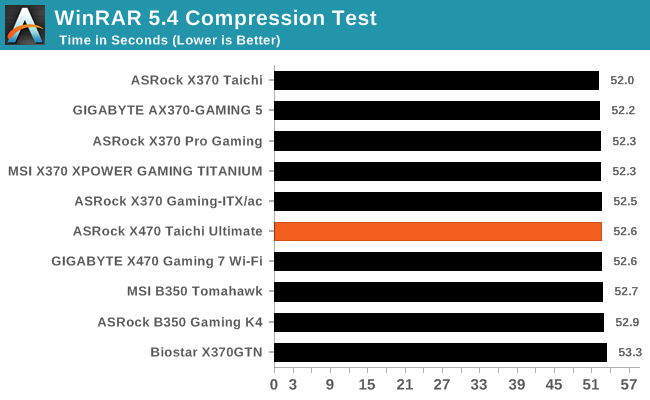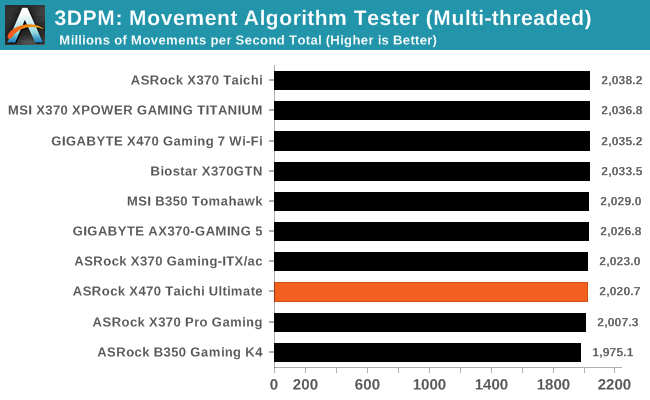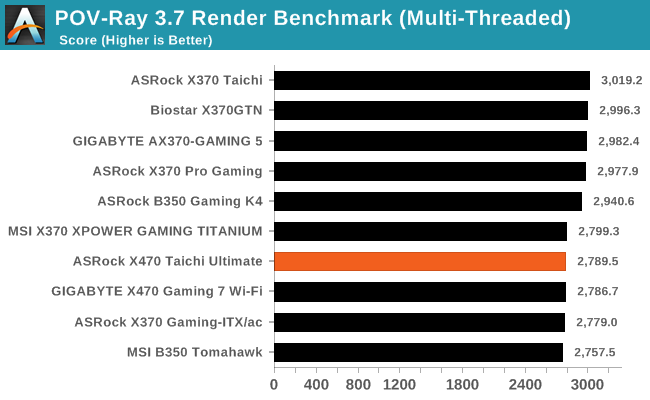The ASRock X470 Taichi Ultimate Motherboard Review: Aquantia 10GbE on Ryzen
by Gavin Bonshor on August 2, 2018 9:00 AM ESTCPU Performance, Short Form
For our motherboard reviews, we use our short form testing method. These tests usually focus on if a motherboard is using MultiCore Turbo (the feature used to have maximum turbo on at all times, giving a frequency advantage), or if there are slight gains to be had from tweaking the firmware. We put the memory settings at the CPU manufacturers suggested frequency, making it very easy to see which motherboards have MCT enabled by default.
Video Conversion – Handbrake v1.0.2: link
Handbrake is a media conversion tool that was initially designed to help DVD ISOs and Video CDs into more common video formats. For HandBrake, we take two videos and convert them to x264 format in an MP4 container: a 2h20 640x266 DVD rip and a 10min double UHD 3840x4320 animation short. We also take the third video and transcode it to HEVC. Results are given in terms of the frames per second processed, and HandBrake uses as many threads as possible.



Compression – WinRAR 5.4: link
Our WinRAR test from 2013 is updated to the latest version of WinRAR at the start of 2017. We compress a set of 2867 files across 320 folders totaling 1.52 GB in size – 95% of these files are small typical website files, and the rest (90% of the size) are small 30 second 720p videos.

Point Calculations – 3D Movement Algorithm Test v2.1: link
3DPM is a self-penned benchmark, taking basic 3D movement algorithms used in Brownian Motion simulations and testing them for speed. High floating point performance, MHz and IPC wins in the single thread version, whereas the multithread version has to handle the threads and loves more cores. For a brief explanation of the platform agnostic coding behind this benchmark, see my forum post here. We are using the latest version of 3DPM, which has a significant number of tweaks over the original version to avoid issues with cache management and speeding up some of the algorithms.

Rendering – POV-Ray 3.7.1b4: link
The Persistence of Vision Ray Tracer, or POV-Ray, is a freeware package for as the name suggests, ray tracing. It is a pure renderer, rather than modeling software, but the latest beta version contains a handy benchmark for stressing all processing threads on a platform. We have been using this test in motherboard reviews to test memory stability at various CPU speeds to good effect – if it passes the test, the IMC in the CPU is stable for a given CPU speed. As a CPU test, it runs for approximately 2-3 minutes on high end platforms.

Synthetic – 7-Zip 9.2: link
As an open source compression tool, 7-Zip is a popular tool for making sets of files easier to handle and transfer. The software offers up its own benchmark, to which we report the result.











41 Comments
View All Comments
LJM - Thursday, August 2, 2018 - link
Indeed I was. Thanks.Goty - Thursday, August 2, 2018 - link
So... no networking tests?PeachNCream - Thursday, August 2, 2018 - link
There's probably no equipment available to perform those tests. 10G switches and NICs aren't commonplace or affordable right now. Then again, Anandtech has done little in the way of network adapter testing and this article puts the network features of the board in question up as a headline feature, but does not quantify that feature in a comparative benchmark. That's a bit of a miss in my opinion and should be something rectified in the future.hansmuff - Thursday, August 2, 2018 - link
I would think a single 10G NIC would be enough, Startech sells one for $230. Pop that into any motherboard and at least do some simple iperf, "LAN Speed Test" or NetStress. Settle on one and use that going forward.DigitalFreak - Thursday, August 2, 2018 - link
No need to even spend that much. You can buy an Aquantia AQC107 NIC for $85.hansmuff - Thursday, August 2, 2018 - link
Huh, nice to know.. are there any 10 Gbps switches in a somewhat affordable range yet ($150-$200 4 port)?CheapSushi - Friday, August 3, 2018 - link
It's not 4 port but the cheap options are ASUS XG-U2008 & Netgear GS110MX. Also keep it mind you can direct connect two setups together say for a NAS to main rig without a switch. And the benefit of these newer switches and chips is that they're not finicky about what speed they're on; it's dynamic, so 10G, 5G, 2.5G, 1G and 100MB, etc.AdrianB1 - Thursday, August 2, 2018 - link
Good question, especially as mentioned the board is the Taichi plus the NIC, so the review is actually for the Taichi, not for Taichi Ultimate.LAN testing can be performed with another board with an Aquantia board with no switch, just a direct cable connection. And this board has also 2.5 and 5 Gbps capabilities, it would be interesting to see how well the real throughput scales: it depends a lot on how the chip is connected - how many lanes of which PCIe version. One needs 4x PCIe ver 2 or 2x PCIe ver 3 for full 10 Gbps, but there are not so many available PCIe lanes and the chip may be connected to half or a quarter of what it needs. That way you still get close to 5 Gbps one-way or even 8-9 Gbps one way, assuming the Aquantia chip can do that, but not full duplex 10 Gbps.
DigitalFreak - Thursday, August 2, 2018 - link
Unfortunately Asrock doesn't include a PCI-E diagram in their manual, so there's no way to know. It could be either PCI-E 2.0 x1, x2 or x4.Cygni - Thursday, August 2, 2018 - link
Its the same chipset and implementation that Aquantia has been selling on motherboards and add on cards for a while. That would be like testing the i211AT on the other port, its a pretty known quantity at this point.